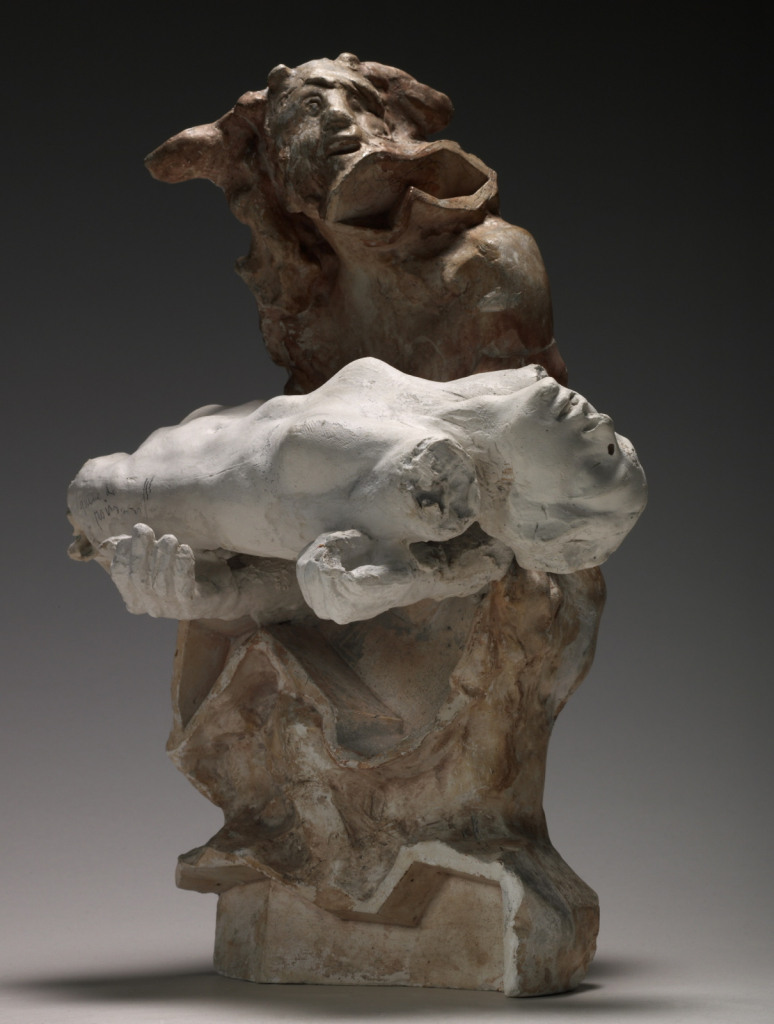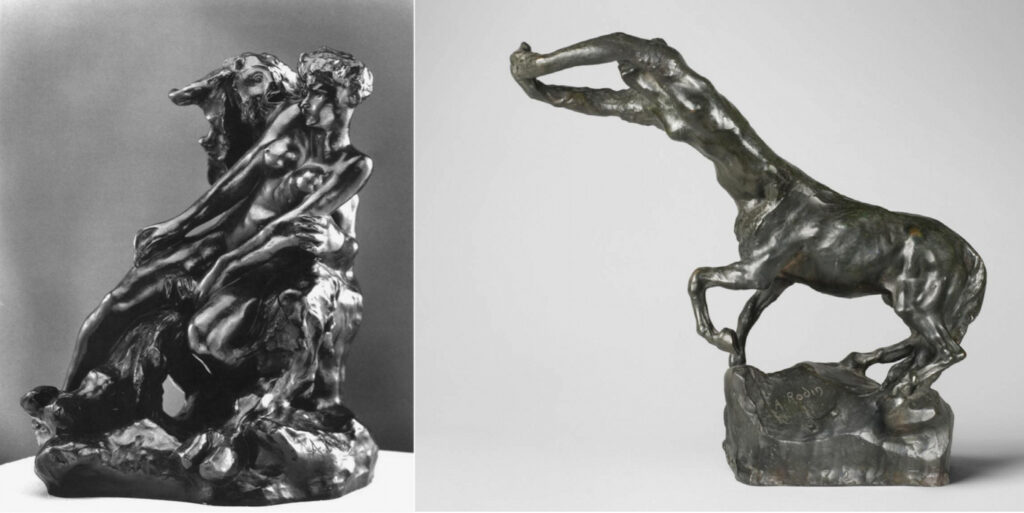
Hyperallergic has an awesome article by John Yau, one of our greatest Jasper Johns whisperers, that uncovers the source of a traced form the artist used in more than 40 works beginning in 1990, but which he had refused to identify. The motif appears to be two figures, one horizontal across the middle of the more vertical one, and is referred to by the name of the painting where it first appeared, Green Angel (1990). As you might expect with Johns, the revelation of the source for the Green Angel form is not a mystery solved, but a prompt for new questions.

Yau credits in the most oblique way possible artist and Cooper Union professor Cristóbal Lehyt with identifying the Green Angel source. It is–SPOILER ALERT –a small, rough, plaster assemblage at the Rodin Museum in Paris called Torse de la Centauresse et Minotaure. Which, I have questions. But first, Lehyt. Why did he bring the find to Yau? Is it because Yau is known to have a relationship with Johns, in addition to being an active participant in the Johns Discourse? How did Lehyt identify it? His own art practice seems to involve a lot of tracing, so presumably, his eye is primed for recognizing silhouettes. Was he searching for it? Is Green Angel one of those grail subjects in the tracing world? Did he interpolate from the Musée Rodin’s published photos, because they’re not actually the form Johns traced? If not, then where did he find it, and is that presumably where Johns found it, too? That feels relevant. These are questions about the discovery that Yau largely elides in his essay. They’re part of the tick tock unfolding of the story, but they also veer toward more central issues of Johns and his work.
[Sept. 2021 update: It’s not clear when, but sometime after posting this, Yau added to his account of Lehyt’s discovery and communication. Apparently Lehyt spotted the Rodin in a 2002 book edited by Bruno Latour and Peter Weibel. Though the book postdates Johns’ paintings, the image does match the outline of his forms.]
In previous tracings, Johns used identifiable artworks: Grünewald’s Eisenheim Altarpiece; Cezanne’s Bathers; a Holbein royal portrait. Later he uses obscure photos–John Deakin’s photo of Lucien Freud, and Larry Burrows’ picture of a weeping soldier in Vietnam–where finding them in an auction catalogue or LIFE magazine is part to the narrative. The Rodin that became Green Angel is neither of these; it’s obscure and obscured, its path to tracing untraceable.
Which is all by choice. Johns elected not to identify his Rodin source, or how he came to it, or why. In that vacuum, scholars and critics interpreted and speculated while Johns kept quiet, and busy. How will perceptions and understanding of the dozens of Green Angel artworks change now? How will this motif change now that its source is known?
Speaking of which, what do we know about Rodin’s Torse de la Centauresse et Minotaure? Yau, notably, does not include an image of it. He does ruminate on Johns’ possible identification with the Rodin’s tormented, eroticized, fractured monsters. As someone close to both the artist and his work, that carries a lot of weight. And others have read later traced figures of broken down Farley or crumpled Freud as stand-ins for the artist. [Though, oddly, I haven’t seen many suggestions that Johns identifies himself with Holbein’s young noble holding a lemur, or Grünewald’s demon and/or crucified Christ.]
Without that experience, I’m left to research this odd sculpture itself, which does not seem to be very frequently published, and is not obviously even on view at the Musée. What its status was before 1990, whenever and however Johns encountered it is even more unclear. Was the sculpture’s rawness and marginalization part of its appeal?

One thing I noticed is the minotaur and centauress as figures within Rodin’s work. Two related works are discussed next to each other in the catalogue for the Cantors’ collection of Rodins at Stanford. “This is perhaps the most erotic work that Rodin exhibited, and it was shown often,” begins the description of the 1886 bronze Minotaure, whose alternate title, Faun and Nymph, hints at why. The bullish head feels very similar to Johns’ source.
Even more recognizable is the elongated human female torso on La Centauresse (c1887). As John Tancock notes in his guide to the sculptures at Philadelphia’s Rodin Museum, the female torso, male head, and horse body are all components Rodin assembled from other contemporary sculptures in his studio. Is it important that these components and variations date from the 1880s, but the assemblage Johns used is dated from 1910 or later?
Maybe Johns identifies with the fractured and tormented creatures Rodin mashed together. Or maybe Johns identified with Rodin, who made his works from the elements of the world around him, including the contents of his studio. Or maybe Johns identified a form that intrigued him, one whose associations and references didn’t push their way to the fore, and he decided to use it to make paintings and prints. As we move toward two massive Johns shows in two cities, and a biography, I expect we’ll have more revealing fan drops ahead.
Jasper Johns: Hiding in Plain Sight [hyperallergic]
Assemblage : Torse de la Centauresse et Minotaure [musée rodin]
Cristóbal Lehyt [cristoballehytrendic.com]
